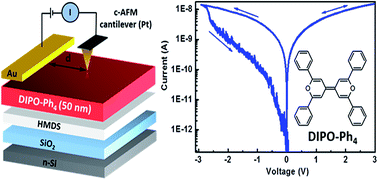A non-volatile resistive memory effect in 2,2′,6,6′-tetraphenyl-dipyranylidene thin films as observed in field-effect transistors and by conductive atomic force microscopy†
Abstract
The charge transport properties of 2,2′,6,6′-tetraphenyldipyranylidene (DIPO-Ph4), a large planar quinoïd π-conjugated heterocycle, are investigated in field-effect transistor (FET) configuration and by conductive atomic force microscopy (c-AFM). The FET properties show a clear p-type behavior with a hole mobility up to 2 × 10−2 cm2 V−1 s−1 and on/off ratio of 104. The transfer characteristics Id/Vg present a clear hysteresis typical of a resistive memory effect. This memory effect is again observed by means of c-AFM in lateral mode using a nearby gold top-contact as the counter-electrode. The c-AFM current response recorded for variable distances d = 0.5–9.0 μm between the AFM tip and the top electrode shows a resistive switching behavior in the low-voltage 0.0–3.0 V region. Repeated “write-read-erase-read” cycles performed at low frequency reveal a non-volatile memory effect in the form of high-resistance and low-resistance states with a stable on/off ratio of 102 during cycling operation.



 Please wait while we load your content...
Please wait while we load your content...